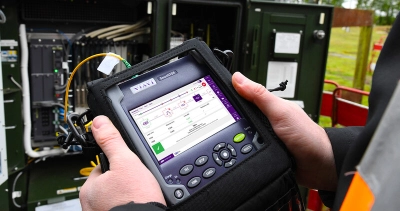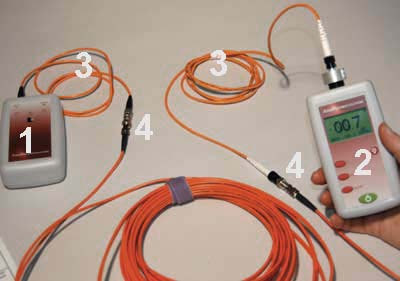Discover the Value of Optical Fiber Screening in Modern Telecom
In the realm of modern-day telecommunications, the significance of optical fiber testing can not be overemphasized, as it offers as the foundation for making sure network integrity and efficiency. What are the specific benefits that regular testing offers, and just how might it form the future landscape of telecommunications?

Understanding Optical Fiber Testing
Optical fiber screening is an important process in telecoms that makes sure the integrity and efficiency of fibre optic networks. This testing incorporates a range of treatments created to review the physical and functional characteristics of optical fibres - optical fibre diameter analyser. Trick criteria assessed consist of optical power loss, bandwidth capability, and fault area, which are essential for preserving high-quality interaction web links
The testing process normally involves using specific devices such as Optical Time-Domain Reflectometers (OTDR) and Optical Power Meters. OTDRs are utilized to recognize and characterize faults, mates, and adapters within the fiber, while power meters determine the transmitted light signal stamina to ascertain effectiveness.
Moreover, testing is performed at different stages, consisting of throughout installment, upkeep, and troubleshooting, to guarantee that the network meets market requirements and functional requirements. Compliance with requirements set by organizations like the International Telecommunication Union (ITU) and the Telecoms Industry Organization (TIA) is paramount.
Benefits of Routine Evaluating
Normal screening of optical fibers returns various advantages that considerably improve network dependability and efficiency. Among the key advantages is the early discovery of potential problems, such as breaks or deterioration in the fiber, which can result in expensive downtime if left unaddressed (ofda). By determining these problems proactively, telecommunications carriers can decrease solution disruptions and guarantee consistent connectivity for their customers
Furthermore, normal screening helps to maintain the honesty of signal quality. As optical fibres age, their efficiency can be influenced by aspects such as ecological problems and physical stress. Regular evaluations permit for the tracking of signal loss and total transmission efficiency, making sure that the network operates at ideal levels.
An additional significant benefit is conformity with sector standards. Regular screening sustains adherence to regulatory needs, thereby minimizing lawful and economic threats linked with non-compliance. It boosts the overall life-span of the fiber framework by helping with timely maintenance and repair work.

Common Testing Methods
Evaluating optical fibers uses various approaches to ensure the honesty and efficiency of telecoms networks. Among one of the most typical methods is Optical Time Domain Reflectometry (OTDR), which evaluates the entire length of the fibre by sending out a pulse of light and gauging the reflections created by blemishes or breaks. This method gives thorough info concerning the location and intensity of faults.
One more common technique is making use of Optical Power Meters, which determine the quantity of light transferred through the fibre. This technique assists determine the loss of signal stamina, making sure that it fulfills sector standards. Additionally, Aesthetic Fault Locators (VFL) are employed to recognize breaks or severe bends in the fibre by forecasting a noticeable laser light right into the cable.
Insertion loss screening is also important, as it evaluates the loss of signal power arising from connections and mates within the network. Furthermore, the usage of Polarization Setting Diffusion (PMD) testing evaluates the effect of fibre features on signal stability.
Each of these approaches plays an important function in keeping the efficiency and dependability of optical fiber networks, inevitably adding to seamless telecoms operations.
Effect On Network Performance
The stability and performance of optical fiber networks straight influence general network efficiency. In modern-day telecommunications, the performance of information transmission relies greatly on the top quality of the optical fibres used. Any kind of deterioration in the fiber's problem-- whether due to physical damage, contamination, or excessive flexing-- can lead to raised attenuation and signal loss, significantly discover this info here affecting data honesty and rate.
Routine optical fiber testing is crucial to recognize and rectify prospective concerns prior to they show up as network failings or stagnations. Techniques such as Optical Time Domain Reflectometry (OTDR) and insertion loss screening enable technicians to determine the efficiency of fibre links properly. These examinations not only evaluate the physical problem of the fibers yet also guarantee compliance with sector requirements, therefore protecting the network's reliability.
Moreover, a well-maintained optical fiber network adds to minimized operational prices and enhanced customer fulfillment, as end-users experience fewer disruptions and greater information prices. Eventually, the focus on strenuous optical fiber screening practices serves as a cornerstone for maintaining robust telecoms infrastructure, ensuring that provider can satisfy the expanding demands for bandwidth and connection in today's electronic age.
Future Patterns in Testing
As we look ahead, advancements in technology are poised to improve optical fibre screening in telecoms. The increase of automation and synthetic knowledge (AI) is expected to improve the performance and accuracy of screening processes. Automated screening systems can perform thorough analyses with minimal human intervention, substantially decreasing the possibility for errors and quickening time-to-deployment.
Moreover, the combination of artificial intelligence formulas will enable predictive maintenance, allowing network suppliers to predict prospective concerns prior to they rise into failures. This positive approach not only improves network dependability but additionally optimizes operational prices.
Another emerging trend is the development of mobile testing tools that use real-time evaluation - optical fibre diameter analyser. These tools will read more certainly encourage technicians to carry out on-site diagnostics swiftly, helping with quicker resolutions and enhancing service quality
The growth of 5G networks additionally demands the development of screening methods. As data transfer needs increase, typical testing strategies might no much longer are sufficient. Ingenious services such as optical time-domain reflectometry (OTDR) and advanced spooky analysis will certainly become essential in guaranteeing the honesty and efficiency of high-speed links.

Verdict
Finally, optical fibre testing is necessary for making certain the integrity and integrity of modern telecoms networks. Normal testing techniques not only assist determine prospective problems such as signal loss and mistakes yet also add to improved network performance visit this site and client fulfillment. As the demand for seamless connectivity proceeds to grow, the adoption of advanced screening methods will play a crucial role in preserving top quality network criteria and supporting the developing landscape of telecoms.
 Jason J. Richter Then & Now!
Jason J. Richter Then & Now! Ross Bagley Then & Now!
Ross Bagley Then & Now! Bo Derek Then & Now!
Bo Derek Then & Now! Dolly Parton Then & Now!
Dolly Parton Then & Now! Jaclyn Smith Then & Now!
Jaclyn Smith Then & Now!